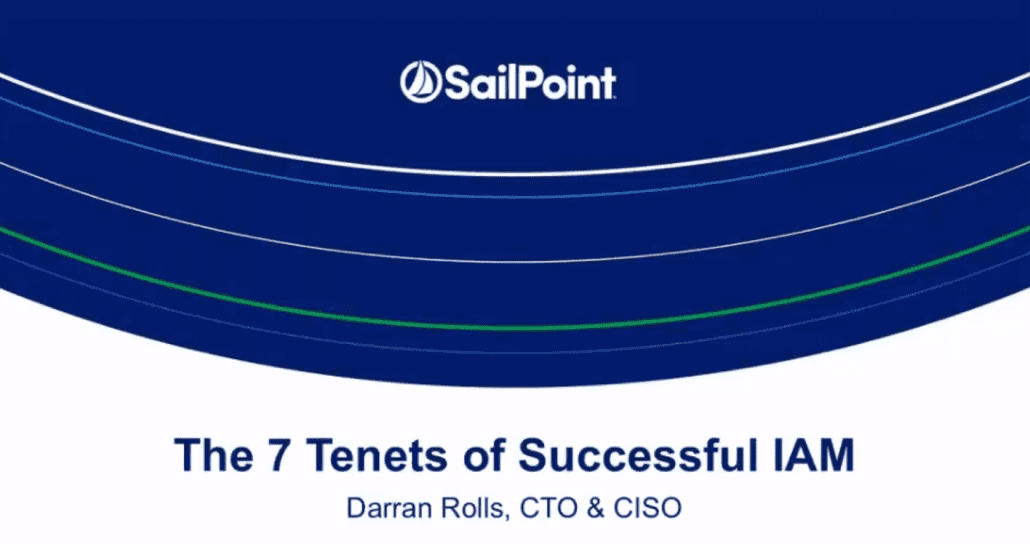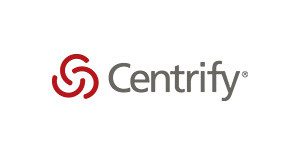7 Tenets of Successful IAM (webinar)

SailPoint CTO and CISO Darran Rolls discusses the seven tenets of a successful IAM program in this informative webinar (59:15)
7 Tenets of Successful IAM (webinar)

SailPoint CTO and CISO Darran Rolls discusses the seven tenets of a successful IAM program in this informative webinar (59:15)
7 Tenets of Successful IAM (webinar)
 Today you live with the risks of users accessing many more services outside the corporate network perimeter as well as users carrying many more devices to access these services. Users have too many passwords and the passwords are inherently weak. In fact passwords have become more of an impediment to users than they are protection from hackers and other malevolent individuals and organizations. In short, in many cases, passwords alone cannot be trusted to properly and securely identify users.
Today you live with the risks of users accessing many more services outside the corporate network perimeter as well as users carrying many more devices to access these services. Users have too many passwords and the passwords are inherently weak. In fact passwords have become more of an impediment to users than they are protection from hackers and other malevolent individuals and organizations. In short, in many cases, passwords alone cannot be trusted to properly and securely identify users.
Consequently, you need a better solution that incorporates strong authentication and one that delivers a common multi-factor experience across all your apps — SaaS, cloud, mobile, and onpremises. The solution also needs to have access policies that take into account the complete context of the access request and helps to overcome these new security risks. In addition, you need the capability to establish flexible access policies for each app for more granular and adaptive control. For example, if a user is accessing a common app from a trusted device on the corporate network from his home country during business hours ,then simply allow him silent SSO access to the apps. But if that same user is accessing an app outside the corporate network from a device that is not trusted, outside of business hours, and from a foreign country then deny them access — or at least require additional factors of authentication.
Specifically, you need an IDaaS solution that ensures security authentication by combining multi-factor authentication (MFA) and rich, flexible per-app authentication policies.
Multifactor authentication methods should include at least:
• Soft token with one-button authentication to simplify the experience
• One Time Passcode (OTP) over SMS text or email
• Interactive Phone Call to the user’s mobile device and requirement for a confirmation before authentication can proceed
• User configurable security question to act as a second password
Per-app authentication policies should allow, deny or step up authentication based on a rich understanding of the context of the request based on any combination of:
• Time of day, work hours
• Inside/Outside corporate network
• User role or attributes
• Device attributes (type, management status)
• Location of request or location of user’s other devices
• App client attributes
• Custom logic based on specific organizational needs

Identity and access management is a strategic imperative for organizations of all sizes. Companies ranging from large, multi-national enterprises to smaller, fast-growing businesses must address requirements to protect and govern access to critical applications, systems and databases whether in the cloud or on-premises. Identity and access management plays a critical role in enabling organizations to inventory, analyze and understand the access privileges granted to their employees — and to be ready to answer the critical question: “Who has access to what?” At the same time, today’s enterprise demands faster and higher levels of service delivery across an increasingly diverse and dynamic environment:
For IT staff, the challenge becomes how to meet service-level demands while identifying and managing high-risk activities, enforcing policy and security, maintaining stringent controls and addressing compliance requirements. Because there are many different business drivers for identity and access management, you may wonder how and when to put the different components of a solution in place. The answer depends on your business priorities and the immediate challenges facing your organization. To get started, step back and assess your most urgent issues. Do you understand what you want your solution to help you achieve? Here are some common business goals that can help you determine your own unique priorities:
Be sure to read blog #2, Speed Delivery of Access to Business Users, for more detail about the business drivers for identity management — the goals organizations most frequently hope to achieve with their implementation.
Visit SailPoint Technologies, Inc. here.
Learn more about PathMaker Group IAM MAP here.
PathMaker Group has been working in the Identity and Access Management space since 2003. We take pride in delivering quality IAM solutions with the best vendor products available. As the vendor landscape changed with mergers and acquisitions, we specialized in the products and vendors that led the market with key capabilities, enterprise scale, reliable customer support and strong partner programs. As the market evolves to address new business problems, regulatory requirements, and emerging technologies, PathMaker Group has continued to expand our vendor relationships to meet these changes. For many customers, the requirements for traditional on premise IAM hasn’t changed. We will continue supporting these needs with products from IBM and Oracle. To meet many of the new challenges, we have added new vendor solutions we believe lead the IAM space in meeting specific requirements. Here are some highlights:
IoT/Consumer Scalability
UnboundID offers a next-generation IAM platform that can be used across multiple large-scale identity scenarios such as retail, Internet of Things or public sector. The UnboundID Data Store delivers unprecedented web scale data storage capabilities to handle billions of identities along with the security, application and device data associated with each profile. The UnboundID Data Broker is designed to manage real-time policy-based decisions according to profile data. The UnboundID Data Sync uses high throughput and low latency to provide real-time data synchronization across organizations, disparate data systems or even on-premise and cloud components. Finally, the UnboundID Analytics Engine gives you the information you need to optimize performance, improve services and meet auditing and SLA requirements.
Identity and Data Governance
SailPoint provides industry leading IAM governance capabilities for both on-premise and cloud-based scenarios. IdentityIQ is Sailpoint’s on-premise governance-based identity and access management solution that delivers a unified approach to compliance, password management and provisioning activities. IdentityNow is a full-featured cloud-based IAM solution that delivers single sign-on, password management, provisioning, and access certification services for cloud, mobile, and on-premises applications. SecurityIQ is Sailpoint’s newest offering that can provide governance for unstructured data as well as assisting with data discovery and classification, permission management and real-time policy monitoring and notifications.
Cloud/SaaS SSO, Privileged Access and EMM
Finally, Centrify provides advanced privileged access management, enterprise mobility management, cloud-based access control for customers across industries and around the world. The Centrify Identity Service provides a Software as a Service (SaaS) product that includes single sign-on, multi-factor authentication, enterprise mobility management as well as seamless application integration. The Centrify Privilege Service provides simple cloud-based control of all of your privileged accounts while providing extremely detailed session monitoring, logging and reporting capabilities. The Centrify Server Suite provides the ability to leverage Active Directory as the source of privilege and access management across your Unix, Linux and Windows server infrastructure.
With the addition of these three vendors, PMG can help address key gaps in a customer’s IAM capability. To better understand the eight levers of IAM Maturity and where you may have gaps, take a look this blog by our CEO, Keith Squires about the IAM MAP. Please reach out to see how PathMaker Group, using industry-leading products and our tried and true delivery methodology, can help get your company started on the journey to IAM maturity.
Corporations are increasingly utilizing mobile enterprise systems to meet their business objectives, allowing mobile devices such as smart phones and tablets to access critical applications on their corporate network. These devices provide advanced technologies over traditional desktop clients, such as: information sharing, access from anywhere at any time, data sensors, location, etc. But what makes these mobile devices desirable, by their very nature, also poses a new set of security challenges. Reports by research agencies in recent years show an alarming trend in mobile security threats listing as top concerns: Android malware attacks, and for the IOS platform issues with enterprise provisioning abuse and older OS versions.
These trends highlight the need for corporations to start taking seriously a mobile security strategy at the same level to which cyber criminals are planning future attacks. A mobile security strategy might involve adopting certain Mobile Security Guidelines as published by standards organizations (NIST) and Mobile OWASP project. See the references at the end of this document:
The following guidelines are a subset of Mobile Security Guidelines I pulled from various published sources with most coming from NIST. It is by no means a comprehensive list, however they can be considered as a starting point or additional considerations for an existing mobile security strategy.
1 – Understand the Mobile Enterprise Architecture
You should start with understanding and diagramming the flow from mobile application to business applications running on the back-end application server. This is a great starting point and should be done at the beginning stages, as most of the security guidelines will depend on what is known about the architecture.
2 – Diagram the network topology of how the mobile devices connect
Is the mobile device connecting to the business application servers over the cellular network or internally through a private WiFi network, or both? Does it go through a proxy or firewall? This type of information will aid in developing security requirements; help with establishing a QA security test bed and monitoring capability.
3 – Develop Mobile Application Security Requirements
At a high level, a security function must protect against unauthorized access and in many cases protect privacy and sensitive data. In most cases, building security into mobile applications is not at the top of the mind-set in the software development process. As such, these requirements should be gathered as soon as possible in the Software Development Life Cycle (SDLC). It has been my personal experience in many cases that you have to work with application software developers in adopting best security practices. So the sooner you can get that dialogue going the better. Security objectives to consider are: Confidentiality, integrity, and availability. Can the mobile OS platform provide the security services required? How sensitive is the data you are trying to protect. Should the data be encrypted in transit, and in storage? Do you need to consider data-in-motion protection technologies? Should an Identity and Access Management (IDAM) solution be architected as part of the mobile enterprise system? Should it include a Single Sign On functionality (SSO)? Should there be multi-factor authentication, role based or fine-grained access control? Is Federation required? Should the code be obfuscated to prevent reverse engineering?
4 – Incorporate a Mobile Device Security Policy
What types of mobile devices should be allowed to access the organization’s critical assets. Should you allow personal mobile devices, Bring Your Own Devices (BYOD’s) or consider only organization-issued or certified mobile devices to access certain resources? Should you enforce tiers of access? Centralized mobile device management technologies are a growing solution for controlling the use of both organization-issued and BYOD’s by enterprise users. These technologies can remotely wipe the data or lock the password from a mobile device that has been lost or stolen. Should Enterprises consider anti malware software and OS upgrades to become certified mobiles on the network? To reduce high risk mobile devices, consider technologies that can detect and ban mobile devices that are jail broken or rooted, as these can pose the greatest risk of being compromised by hackers.
5 – Application Security Testing
According to a study performed by The Ponemon Institute, nearly 40% of 400 companies surveyed were not scanning their applications for security vulnerabilities, leaving the door wide open for cyber-attacks. This highlights the urgency for security teams to put together some sort of security vetting process to identify security vulnerabilities and validate security requirements as part of an ongoing QA security testing function. Scanning application technologies typically conduct two types of scanning methods: Static Application Security Testing (SAST) which analyzes the source code and Dynamic Application Security Testing (DAST), which sends modified HTTP requests to a running web application to exploit the application vulnerabilities. As the QA scanning process develops, it can be automated and injected into the software build process to detect security issues in the early phases of the SDLC.
6 – System Threat Model, Risk Management Process
What will typically come out of the application scanning process will be a list of security vulnerabilities found as either noise, suspect or definitive. It will then be up to the security engineers knowing the system architecture and network topology working with the application developer to determine whether the vulnerability results in a valid threat and what risk level based on the impact of a possible security breach. Once the risk for each application is determined, it can be managed through an enterprise risk management system where vulnerabilities are tracked, fixed and the risk brought down to a more tolerable level.
7 – Consider implementing a Centralized Mobile Device Management System
Depending on the Mobile Security Policy that is in place, you may want to consider implementing a Centralized Mobile Device Management System especially when Bring Your Own Device (BYOD) mobiles are in the mix that can:
8 – Security Information and Event Management (SIEM)
Monitor mobile device traffic to back-end business applications. Track mobile devices and critical business applications and correlate with events and log information looking for malicious activity based on threat intelligence. On some platforms it may be possible to integrate with a centralized risk management system to specifically be on alert for suspicious mobile events correlated with applications at higher risk.
References:
We were sitting down with a client during some initial prioritization discussions in an Identity and Access Management (IAM) Roadmap effort, when the talk turned to entitlements and how they were currently being handled. Like many companies, they did not have a unified approach on how they wanted to manage entitlements in their new world of unified IAM (a.k.a. the end of the 3 year roadmap we were helping to develop). Their definition of entitlements also varied from person to person, much less how they wanted to define and enforce them. We decided to take a step back and really dig into entitlements, entitlement enforcement, and some of the other factors that come into play, so we could put together a realistic enterprise entitlement management approach. We ended up having a really great discussion that touched on many areas within their enterprise. I wanted to briefly discuss a few of the topics that really seemed to resonate with the audience of stakeholders sitting in that meeting room.
(For the purpose of this discussion, entitlements refer to the privileges, permissions or access rights that a user is given within a particular application or group of applications. These rights are enforced by a set of tools that operate based on the defined policies put in place by the organization. Got it?)
There are no cut and dry answers for these questions, as it truly will vary from application to application and organization to organization. The important part is to come to a consensus on the approach and then provide the application teams, developers and security staff the tools to manage entitlements going forward.
It seems all too often that when users are unable to access an end-user business function protected by a IDAM (Identity and Access Management) solution, the IDAM system gets the brunt of the blame and in a lot of cases without justification. Today’s corporate web based business functions are comprised of complex systems based on a service oriented applications. As such, it can be difficult to diagnose particular issues in a timely manner to preclude having to restart several components. As the issue persists, security controls may be removed or bypassed all together resulting in another set of problems. In many cases the root cause does not get identified and a repeat incident occurs.
Consider a system that hosts a web application providing an end-user business function to allow users to sign up for service and be able to pay their bills online. To protect the web application, an Oracle IDAM system, referred to as the SSO Stack, is implemented to provide access control and data protection for the end-users. As you can see, there are a lot of complicated flows and dependencies in the systems.
Suppose an issue has been reported by an end-user and technical support personnel are logged in to try and resolve the issue. To illustrate the complexity of the issue, suppose an end-user cannot access the system to pay their bill. Without having an in-depth knowledge of what is going on inside the systems, it is difficult to determine if the web application is the problem or if the problem is related to the SSO Stack. If it is the SSO Stack, which component is at fault?
Remember the movie, the matrix, “take the red pill” and find out what is really going on in the matrix. “Take the blue pill” and you live in ignorance and bliss. When troubleshooting systems, the tendency is to: collect and analyze logs on each of the system components independently, trouble-shoot at the network level, and execute manual user tests, all time consuming. How many times have you heard someone say “I can ping the server just fine” yet the problem persists.
“What if I told you”, testing at the application layer provides a more accurate indication of what is really going on inside the system. The business functionality is either working as intended or it is not. Applications performing the business functions can be modeled as services and tested in real-time. Service tests can measure the end-user’s ability to access a service and if automated, allow issues to be resolved before end-user complaints start rolling in. Service tests strategically placed in each critical subsystem can be used as health checks determining which system component may be at fault if there are reported issues.
With EM12c Cloud control, business functions can be modeled as services to be monitored for availability and performance. Systems can be defined based on target components hosting the service. As a service is defined, it is associated with a system and one or more service tests. Service tests emulate the way a client would access the service and can be set up using out-of-the-box test frameworks: web testing automation, SQL timing, LDAP, SOAP, Ping tools, etc. and can be extended through Jython based scripting support. The availability of a service can be determined by the results of service tests or the system performance metrics. The results of the system metrics can be utilized in system usage metrics and in conjunction with service level agreements (SLAs). Additionally, aggregate services can be modeled to consist of sub-services with the availability of the aggregate service dependent on the availability of each of the individual sub-services.
Revisiting the issue reported in the previous use-case, it was not a trivial task in determining whether it was or was not an SSO issue and which component or components were at fault. Now consider modeling the consumer service and running web automation end-user service tests against the web application. Consider the SSO stack as a service modeling the Identity and Access Management functionality. The SSO Stack can be defined as an aggregate service with the following subservices: SSO Service, STS Service, Directory Service and Database Service. The availability and performance of the SSO Stack can be measured based on the availability and performance of each of the subservices within the SSO Stack chain. Going back to the problem reported in fig 1, the end-user could not access the web application to pay their bill. Suppose service tests are set up to run at the various endpoints as illustrated in figure 3. As expected, the end-user service tests are showing failures. If the service tests for the Directory Service and Database are passing, it can be concluded the problem is within the OAM server component. Looking further into the results of the SSO Service and STS Service the problematic application within the OAM server can be determined. As this illustration points out, Service tests provide a more systematic way of trouble shooting and can lead you to a speedier resolution and root cause.
The following are some of the features available with the EM12 Cloud Control monitoring solution to provide the capabilities as mentioned not available from the basic Enterprise Manager Fusion Middleware Control.
One of the advanced uses of Oracle Enterprise Manager 12c is being able to manage multiple phases of the cloud lifecycle—such as the planning, set up, build, deployment, monitoring, metering/chargeback, and optimization of the cloud. With its comprehensive management capabilities for clouds, Oracle Enterprise Manager 12c enables rapid deployment and end-to-end monitoring of infrastructure as a service (IaaS), platform as a service (PaaS)—including database as a service (DBaaS), schema as a service (Schema-aaS), and middleware as a service (MWaaS).


 About Ravi Srinivasan:
About Ravi Srinivasan:
PathMaker Group is a specialized Security and Identity Management Consultancy, blending core technical and product expertise, consultative know-how, and extensive implementation experience.
DALLAS-FORT WORTH
635 Fritz Drive
Suite 110
Coppell, TX 75019
(817) 704-3644
info@pathmaker-group.com
